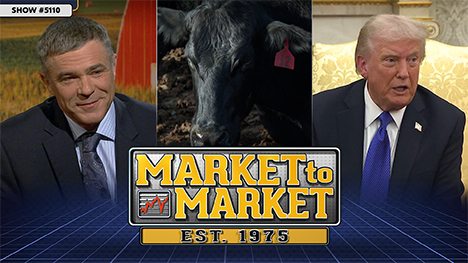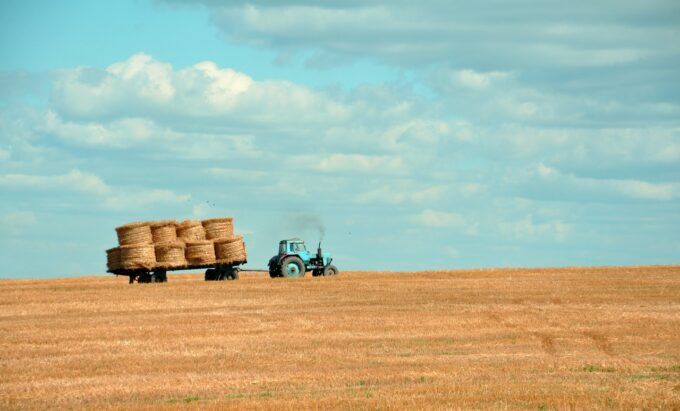Market to Market – October 24, 2025 – Iowa PBS

Report on Agricultural Markets and Sustainable Development
Executive Summary
This report analyzes key developments in agricultural markets, international trade, and food policy for the week ending October 24, 2025. Significant events, including escalating trade tensions between the U.S. and Canada, domestic policy shifts affecting the U.S. cattle industry, and innovations in sustainable agriculture, are examined through the framework of the United Nations Sustainable Development Goals (SDGs). The analysis highlights challenges and opportunities related to SDG 2 (Zero Hunger), SDG 8 (Decent Work and Economic Growth), SDG 12 (Responsible Consumption and Production), SDG 15 (Life on Land), and SDG 17 (Partnerships for the Goals).
International Trade Disputes and Economic Implications
US-Canada Trade Relations and SDG 17
Recent actions have strained trade relations between the United States and Canada, undermining the principles of SDG 17 (Partnerships for the Goals). These developments threaten economic stability and decent work, central to SDG 8 (Decent Work and Economic Growth).
- A Canadian television advertisement critical of U.S. tariff policy prompted the U.S. President to announce a termination of all trade negotiations with Canada.
- In response, Canadian Prime Minister Mark Carney announced a strategy to double non-U.S. exports, signaling a significant pivot away from economic integration with the United States.
- The Prime Minister noted that close economic ties have become a vulnerability, placing jobs in the auto, steel, and lumber industries under threat and causing businesses to hold back investment due to uncertainty.
Domestic Agricultural Policy and Food Systems
US Cattle Industry Challenges and SDG 2
The U.S. cattle industry is facing significant challenges that impact food supply chains and the economic viability of ranchers, directly relating to SDG 2 (Zero Hunger) and SDG 1 (No Poverty). The U.S. cattle inventory is at its smallest since 1973, a result of low herd numbers and persistent drought, which aligns with concerns under SDG 13 (Climate Action).
A presidential announcement to lower domestic beef prices by increasing imports from Argentina has generated significant controversy. This policy decision intersects with SDG 12 (Responsible Consumption and Production) by raising questions about local versus global food sourcing.
Government and Industry Responses
In response to the challenges, the USDA and industry stakeholders have proposed and reacted to several measures:
- The USDA released a plan to assist producers by expanding grazing access on federal land, a measure that impacts SDG 15 (Life on Land).
- The plan includes new enforcement rules for voluntary “Product of the USA” labels and encourages schools to purchase locally raised beef, promoting the goals of SDG 12.
- The proposal raises the import quota on Argentine beef to 176 million pounds. Critics argue this will have a negligible impact on consumer prices while undercutting domestic producers.
- The National Cattlemen’s Beef Association (NCBA) issued a statement opposing the President’s move, arguing it undercuts the future of family farmers and ranchers.
Innovations in Sustainable Agriculture
World Food Prize Highlights Progress on SDG 2 and SDG 15
The 2025 World Food Prize was awarded to Brazilian scientist Mariangela Hungria for her work in biological nitrogen fixation. Her research offers a powerful tool for achieving global food security and environmental protection.
- Hungria’s work utilizes naturally occurring soil bacteria to fix nitrogen, increasing crop yields while reducing farmer dependence on synthetic fertilizers.
- This innovation directly supports SDG 2 (Zero Hunger) by boosting food production and SDG 12 (Responsible Consumption and Production) by promoting sustainable agricultural practices.
- Crucially, Hungria believes this technology can double agricultural productivity in Brazil without further deforestation, a significant contribution to SDG 15 (Life on Land).
- Her recognition also highlights the vital role of women in agriculture, advancing SDG 5 (Gender Equality).
Partnerships for Global Food Security
Former Iowa Governor Tom Vilsack emphasized the need for collaborative efforts to feed the world, reflecting the core of SDG 17 (Partnerships for the Goals). He stressed that partnerships between government, the private sector, non-profits, and individuals are essential to meeting the moral imperative of ensuring every person has access to food.
Market Analysis and Economic Indicators
Commodity Market Performance
Market volatility reflects the ongoing economic uncertainties, impacting the livelihoods of agricultural producers and progress toward SDG 8 (Decent Work and Economic Growth).
- Wheat: The nearby contract added 9 cents, influenced by sanctions against Russia.
- Corn: The December contract gained 1 cent.
- Soybeans: The November contract rose 22 cents on optimism regarding upcoming U.S.-China trade talks.
- Livestock: The cattle complex was sharply lower, with December cattle selling off $7.90 and November feeders down $19.50 following presidential announcements.
- Crude Oil: November crude oil added $4.51 per barrel, partly due to sanctions on Russia.
Economic Context
Broader economic factors continue to influence agricultural markets.
- The U.S. government remains in its fourth week of a shutdown, delaying key agricultural reports.
- The Consumer Price Index (CPI) showed a 3% year-over-year gain, indicating persistent inflation.
- The National Association of Realtors reported a 1.5% increase in existing home sales for September.
Analysis of Sustainable Development Goals in the Article
1. Which SDGs are addressed or connected to the issues highlighted in the article?
- SDG 2: Zero Hunger: The article extensively discusses food production, agricultural productivity, food prices (beef), and the global mission of feeding the world. It touches upon sustainable agricultural practices, challenges faced by farmers and ranchers, and food supply chains.
- SDG 5: Gender Equality: The article highlights the role of women in agriculture through the comments of World Food Prize laureate Mariangela Hungria, who speaks about the historically “invisible and unrecognized” role of women and their potential to lead the future of agriculture.
- SDG 8: Decent Work and Economic Growth: The core of the article revolves around economic issues like international trade, tariffs, and their impact on national industries and jobs. The trade dispute between the U.S. and Canada directly threatens jobs in the auto, steel, and lumber industries.
- SDG 12: Responsible Consumption and Production: The work of Mariangela Hungria on biological nitrogen fixation is presented as a method to achieve sustainable production by reducing dependence on synthetic fertilizers and improving soil health.
- SDG 15: Life on Land: The article connects sustainable agriculture to the protection of terrestrial ecosystems. It explicitly mentions that Hungria’s work could “double agricultural productivity in Brazil without reducing the country’s rainforest.”
- SDG 17: Partnerships for the Goals: The article’s focus on international trade relations, tariffs, and terminated negotiations directly relates to global partnerships for sustainable development. The breakdown of trade talks between the U.S. and Canada is a clear example of challenges to this goal.
2. What specific targets under those SDGs can be identified based on the article’s content?
-
SDG 2: Zero Hunger
- Target 2.3: By 2030, double the agricultural productivity and incomes of small-scale food producers… This target is relevant to the discussion of ranchers who have “lost their shirts for many, many years” and the work of Mariangela Hungria, which aims to “increase crop yields.”
- Target 2.4: By 2030, ensure sustainable food production systems and implement resilient agricultural practices that increase productivity and production, that help maintain ecosystems, that strengthen capacity for adaptation to climate change… This is directly addressed by the description of Hungria’s work in “biological nitrogen fixation” to reduce dependence on synthetic fertilizers and “restoring soil health.”
-
SDG 5: Gender Equality
- Target 5.5: Ensure women’s full and effective participation and equal opportunities for leadership in political, economic and public life. This is highlighted by Laureate Hungria’s statement: “For centuries, women’s role in agriculture have been invisible and unrecognized… I am sure that we will lead agriculture of the future.”
-
SDG 8: Decent Work and Economic Growth
- Target 8.a: Increase Aid for Trade support for developing countries… The article discusses actions contrary to this target, such as the U.S. terminating trade negotiations with Canada and imposing tariffs, which disrupt trade and threaten jobs. The Canadian Prime Minister notes that “the jobs of workers in our industries most affected by the U.S. tariffs… are under threat.”
-
SDG 12: Responsible Consumption and Production
- Target 12.2: By 2030, achieve the sustainable management and efficient use of natural resources. The development of biologicals for nitrogen fixation is a clear example of moving towards more sustainable and efficient resource use by “reducing farmer dependence on synthetic fertilizers.”
-
SDG 15: Life on Land
- Target 15.2: By 2020, promote the implementation of sustainable management of all types of forests, halt deforestation, restore degraded forests and substantially increase afforestation and reforestation globally. This target is directly referenced in the article’s claim that Brazil can “double the area we are cropping without having to cut one tree.”
-
SDG 17: Partnerships for the Goals
- Target 17.10: Promote a universal, rules-based, open, non-discriminatory and equitable multilateral trading system under the World Trade Organization. The article details the breakdown of this system through unilateral actions, such as President Trump’s statement that “all trade negotiations with Canada are hereby terminated” and the use of tariffs.
- Target 17.11: Significantly increase the exports of developing countries… This is relevant to the discussion of raising the “import quota on Argentine beef to 176 million pounds,” which would increase exports from Argentina, a developing country.
3. Are there any indicators mentioned or implied in the article that can be used to measure progress towards the identified targets?
-
SDG 2: Zero Hunger
- Agricultural Productivity: The article mentions a specific goal to “double agricultural productivity in Brazil,” which serves as a direct indicator of progress towards Target 2.3.
- Food Price Inflation: The mention of the “Consumer Price Index” advancing and a “3% gain for inflation” is an indicator that measures food affordability and access, relevant to ensuring access to food for all.
- Livestock Inventory: The article cites “the smallest cattle inventory since 1973” as a key factor in beef supply and pricing, serving as an indicator of food production capacity.
-
SDG 5: Gender Equality
- Recognition of Women in Agriculture: While not a quantitative metric, the statement that women’s roles have been “invisible and unrecognized” implies that an indicator of progress would be the increased visibility, recognition, and leadership of women in the agricultural sector, such as winning the World Food Prize.
-
SDG 8 & 17: Decent Work and Economic Growth & Partnerships for the Goals
- Trade Tariffs: The imposition of tariffs is used as a policy tool and an indicator of trade protectionism. The article states, “I put tariffs on things coming into the country, including beef.”
- Trade Volume and Quotas: Specific figures are mentioned as indicators of trade flows, such as the plan to raise the “import quota on Argentine beef to 176 million pounds” and Canada’s goal to “double its non-US exports.”
- Export Sales Data: The mention of the “U.S. sales meter with the Middle Kingdom at zero” for soybeans is a direct indicator of the impact of trade disputes on exports.
-
SDG 15: Life on Land
- Rate of Deforestation: The goal to expand agriculture “without having to cut one tree” implies that the rate of deforestation is a critical indicator for measuring sustainable land use. A zero or negative rate would indicate success.
4. Summary Table of SDGs, Targets, and Indicators
| SDGs | Targets | Indicators Identified in the Article |
|---|---|---|
| SDG 2: Zero Hunger | 2.3: Double agricultural productivity and incomes of small-scale food producers. 2.4: Ensure sustainable food production systems. |
– Goal to “double agricultural productivity in Brazil.” – Cattle inventory levels (“smallest since 1973”). – Consumer Price Index / Inflation rate (“3% gain for inflation”). |
| SDG 5: Gender Equality | 5.5: Ensure women’s full and effective participation and equal opportunities for leadership. | – Recognition of women’s leadership in agriculture (e.g., winning the World Food Prize). – Qualitative measure of visibility for previously “invisible and unrecognized” roles. |
| SDG 8: Decent Work and Economic Growth | 8.a: Increase Aid for Trade support. | – Imposition of tariffs on goods (e.g., beef, steel, lumber). – Impact on jobs in affected industries. |
| SDG 12: Responsible Consumption and Production | 12.2: Achieve the sustainable management and efficient use of natural resources. | – Reduction in use of synthetic fertilizers through biological nitrogen fixation. |
| SDG 15: Life on Land | 15.2: Halt deforestation. | – Rate of deforestation (implied by the goal to expand agriculture “without having to cut one tree”). |
| SDG 17: Partnerships for the Goals | 17.10: Promote a universal, rules-based, multilateral trading system. 17.11: Significantly increase the exports of developing countries. |
– Termination of trade negotiations. – Import quotas (e.g., “176 million pounds” of Argentine beef). – Volume of exports (e.g., Canada’s plan to “double its non-US exports,” U.S. soybean sales to China at “zero”). |
Source: iowapbs.org
What is Your Reaction?
 Like
0
Like
0
 Dislike
0
Dislike
0
 Love
0
Love
0
 Funny
0
Funny
0
 Angry
0
Angry
0
 Sad
0
Sad
0
 Wow
0
Wow
0
















































/environment-climate-change-and-health-(ech)/water-sanitation-hygiene-and-health-(wsh)/landfill-tuvalu-36092.tmb-1200v.jpg?sfvrsn=5c21fe40_1#)

.jpg.webp?itok=0ZsAnae9#)
























